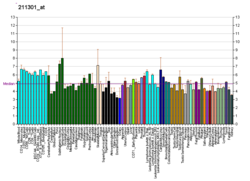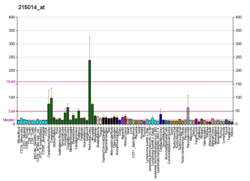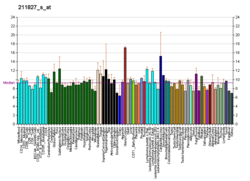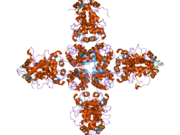KCND3
Potassium voltage-gated channel subfamily D member 3 also known as Kv4.3 is a protein that in humans is encoded by the KCND3 gene.[5][6][7] It contributes to the cardiac transient outward potassium current (Ito1), the main contributing current to the repolarizing phase 1 of the cardiac action potential.[8]
Function
[edit]Voltage-gated potassium (Kv) channels represent the most complex class of voltage-gated ion channels from both functional and structural standpoints. Their diverse functions include regulating neurotransmitter release, heart rate, insulin secretion, neuronal excitability, epithelial electrolyte transport, smooth muscle contraction, and cell volume. Four sequence-related potassium channel genes – shaker, shaw, shab, and shal – have been identified in Drosophila, and each has been shown to have human homolog(s).
Kv4.3 is a member of the potassium channel, voltage-gated, shal-related subfamily, members of which form voltage-activated A-type potassium ion channels and are prominent in the repolarization phase of the action potential. This member includes two isoforms with different sizes, which are encoded by alternatively spliced transcript variants of this gene.[7]
Clinical significance
[edit]Gain of function is believed to cause Brugada syndrome although only indirectly shown by mutations in the beta subunit KCNE3 which causes gain of function of Kv4.3.
See also
[edit]References
[edit]- ^ a b c GRCh38: Ensembl release 89: ENSG00000171385 – Ensembl, May 2017
- ^ a b c GRCm38: Ensembl release 89: ENSMUSG00000040896 – Ensembl, May 2017
- ^ "Human PubMed Reference:". National Center for Biotechnology Information, U.S. National Library of Medicine.
- ^ "Mouse PubMed Reference:". National Center for Biotechnology Information, U.S. National Library of Medicine.
- ^ Postma AV, Bezzina CR, de Vries JF, Wilde AA, Moorman AF, Mannens MM (Aug 2000). "Genomic organisation and chromosomal localisation of two members of the KCND ion channel family, KCND2 and KCND3". Hum Genet. 106 (6): 614–9. doi:10.1007/s004390050033. PMID 10942109.
- ^ Gutman GA, Chandy KG, Grissmer S, Lazdunski M, McKinnon D, Pardo LA, Robertson GA, Rudy B, Sanguinetti MC, Stuhmer W, Wang X (Dec 2005). "International Union of Pharmacology. LIII. Nomenclature and molecular relationships of voltage-gated potassium channels". Pharmacol Rev. 57 (4): 473–508. doi:10.1124/pr.57.4.10. PMID 16382104. S2CID 219195192.
- ^ a b "Entrez Gene: KCND3 potassium voltage-gated channel, Shal-related subfamily, member 3".
- ^ Oudit GY, Kassiri Z, Sah R, Ramirez RJ, Zobel C, Backx PH (May 2001). "The molecular physiology of the cardiac transient outward potassium current (I(to)) in normal and diseased myocardium". J. Mol. Cell. Cardiol. 33 (5): 851–72. doi:10.1006/jmcc.2001.1376. PMID 11343410.
Further reading
[edit]- Serôdio P, Vega-Saenz de Miera E, Rudy B (1997). "Cloning of a novel component of A-type K+ channels operating at subthreshold potentials with unique expression in heart and brain". J. Neurophysiol. 75 (5): 2174–9. doi:10.1152/jn.1996.75.5.2174. PMID 8734615.
- Kong W, Po S, Yamagishi T, et al. (1999). "Isolation and characterization of the human gene encoding Ito: further diversity by alternative mRNA splicing". Am. J. Physiol. 275 (6 Pt 2): H1963–70. doi:10.1152/ajpheart.1998.275.6.H1963. PMID 9843794.
- Dilks D, Ling HP, Cockett M, et al. (1999). "Cloning and expression of the human kv4.3 potassium channel". J. Neurophysiol. 81 (4): 1974–7. doi:10.1152/jn.1999.81.4.1974. PMID 10200233. S2CID 15819057.
- Isbrandt D, Leicher T, Waldschütz R, et al. (2000). "Gene structures and expression profiles of three human KCND (Kv4) potassium channels mediating A-type currents I(TO) and I(SA)". Genomics. 64 (2): 144–54. doi:10.1006/geno.2000.6117. PMID 10729221.
- Deschênes I, Tomaselli GF (2002). "Modulation of Kv4.3 current by accessory subunits". FEBS Lett. 528 (1–3): 183–8. doi:10.1016/S0014-5793(02)03296-9. PMID 12297301.
- Strausberg RL, Feingold EA, Grouse LH, et al. (2003). "Generation and initial analysis of more than 15,000 full-length human and mouse cDNA sequences". Proc. Natl. Acad. Sci. U.S.A. 99 (26): 16899–903. Bibcode:2002PNAS...9916899M. doi:10.1073/pnas.242603899. PMC 139241. PMID 12477932.
- Ren X, Shand SH, Takimoto K (2003). "Effective association of Kv channel-interacting proteins with Kv4 channel is mediated with their unique core peptide". J. Biol. Chem. 278 (44): 43564–70. doi:10.1074/jbc.M302337200. PMID 12928444.
- Hatano N, Ohya S, Muraki K, et al. (2004). "Two arginines in the cytoplasmic C-terminal domain are essential for voltage-dependent regulation of A-type K+ current in the Kv4 channel subfamily". J. Biol. Chem. 279 (7): 5450–9. doi:10.1074/jbc.M302034200. PMID 14645239.
- Scannevin RH, Wang K, Jow F, et al. (2004). "Two N-terminal domains of Kv4 K(+) channels regulate binding to and modulation by KChIP1". Neuron. 41 (4): 587–98. doi:10.1016/S0896-6273(04)00049-2. PMID 14980207. S2CID 17380435.
- Zicha S, Xiao L, Stafford S, et al. (2005). "Transmural expression of transient outward potassium current subunits in normal and failing canine and human hearts". J. Physiol. 561 (Pt 3): 735–48. doi:10.1113/jphysiol.2004.075861. PMC 1665387. PMID 15498806.
- Frank-Hansen R, Larsen LA, Andersen P, et al. (2005). "Mutations in the genes KCND2 and KCND3 encoding the ion channels Kv4.2 and Kv4.3, conducting the cardiac fast transient outward current (ITO,f), are not a frequent cause of long QT syndrome". Clin. Chim. Acta. 351 (1–2): 95–100. doi:10.1016/j.cccn.2004.08.017. PMID 15563876.
- Baltaev R, Strutz-Seebohm N, Korniychuk G, et al. (2005). "Regulation of cardiac shal-related potassium channel Kv 4.3 by serum- and glucocorticoid-inducible kinase isoforms in Xenopus oocytes". Pflügers Arch. 450 (1): 26–33. doi:10.1007/s00424-004-1369-z. PMID 15578212. S2CID 190895.
- Radicke S, Cotella D, Graf EM, et al. (2005). "Expression and function of dipeptidyl-aminopeptidase-like protein 6 as a putative β-subunit of human cardiac transient outward current encoded by Kv4.3". J. Physiol. 565 (Pt 3): 751–6. doi:10.1113/jphysiol.2005.087312. PMC 1464568. PMID 15890703.
- Gregory SG, Barlow KF, McLay KE, et al. (2006). "The DNA sequence and biological annotation of human chromosome 1". Nature. 441 (7091): 315–21. Bibcode:2006Natur.441..315G. doi:10.1038/nature04727. PMID 16710414.
- Lundby A, Olesen SP (2006). "KCNE3 is an inhibitory subunit of the Kv4.3 potassium channel". Biochem. Biophys. Res. Commun. 346 (3): 958–67. doi:10.1016/j.bbrc.2006.06.004. PMID 16782062.
- Ahmed I, Cosen-Binker LI, Leung YM, et al. (2007). "Modulation of the K(v)4.3 channel by syntaxin 1A". Biochem. Biophys. Res. Commun. 358 (3): 789–95. doi:10.1016/j.bbrc.2007.04.182. PMID 17506992.
- Potapova IA, Cohen IS, Doronin SV (2007). "Voltage-gated ion channel Kv4.3 is associated with Rap guanine nucleotide exchange factors and regulates angiotensin receptor type 1 signaling to small G-protein Rap". FEBS J. 274 (17): 4375–84. doi:10.1111/j.1742-4658.2007.05966.x. PMID 17725712.
External links
[edit]- GeneReviews/NIH/NCBI/UW entry on Brugada syndrome
- Kv4.3+Potassium+Channel at the U.S. National Library of Medicine Medical Subject Headings (MeSH)
- Overview of all the structural information available in the PDB for UniProt: Q9UK17 (Potassium voltage-gated channel subfamily D member 3) at the PDBe-KB.
This article incorporates text from the United States National Library of Medicine, which is in the public domain.











